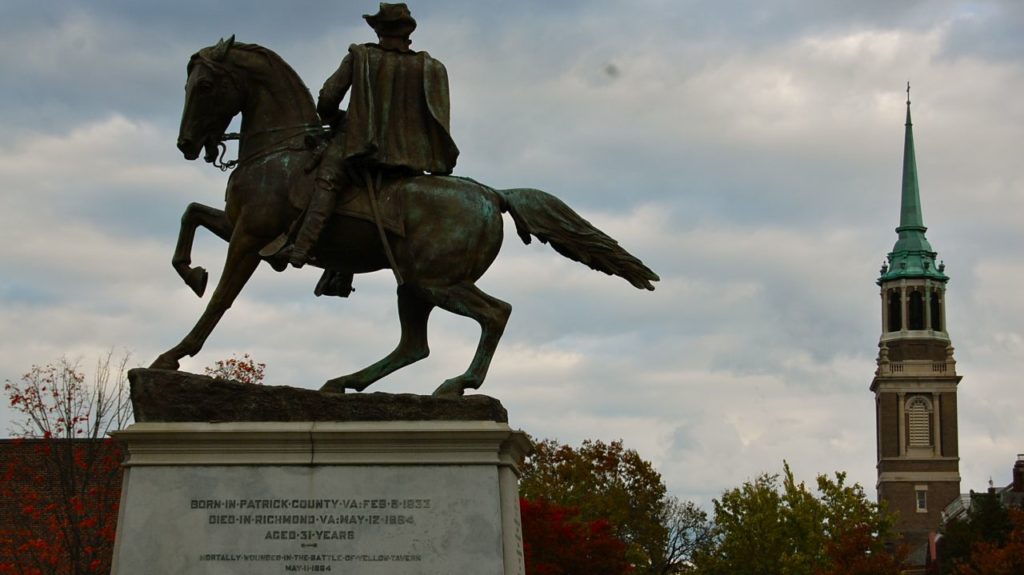The following is an opinion article from contributor Robert P. Winthrop. Winthrop is partner at Winthrop, Jenkins, and Associates, a Virginia based architecture firm specializing in historic renovation. Historic buildings have also been his focus in numerous writings and lectures. As author of The Architecture of Jackson Ward, Cast and Wrought: The Architectural Metalwork of Downtown Richmond, Virginia, and Architecture in Downtown Richmond, Winthrop has established himself as an authority on the city’s architectural history.
Note: opinion articles from guest writers do not necessarily reflect the views of the the editorial staff.
* * *
The serenity and formality of Monument Avenue hides its eccentricity. It is grand, landscaped street lined with statues to the men who lost the Civil War. Monuments are almost universally dedicated to those who win a war. You do not drive down Rommel Boulevard in Berlin. In the United States the statues of the men who won the Civil War are in Washington D.C. and in countless northern cities and towns. Southern cities have monuments to Confederate leaders.
To us the Civil War is an event, to Americans in the later 19th Century it was reality. The loses on both sides were horrendous; for many white Southerners, it was a disastrous failure. A major portion of the white male population was dead or wounded. Richmond and Atlanta were burned. The South was populated by widows and orphans.
Monuments are built to memorialize the dead. Like epitaphs, memorials are no place for truth telling. No one builds a memorial and says that “he died for an unworthy cause.” The dead are always brave and honorable. Jefferson Davis’s never surrender policy may have caused unnecessary death and destruction for the people he led. That is not mentioned on his monument. For those without a father, son, brother or husband the loss is the same without regard to who won the war. Like an epitaph, memorials provide some information, but historic truth is rarely found there.
Monuments are inanimate objects. They cannot be bad or evil any more than a lightning strike or brick falling from a roof parapet can be evil. Lighting can be dangerous, but not morally bad. Monuments seem to be the low hanging fruit of modern disputes. They are just stone and bronze. The don’t fight or talk back. The Romans tended to take of the heads of deposed or bad emperors and replace them with the head of the current emperor. Somehow all the emperors, good and bad make it into the history books even if the statues are headless.
Removing monuments and statues does not change history. Changing attitudes and opinions is a long-term task, slow and difficult. If you want to change history, perhaps you should start with the way history is taught. Changing textbooks and history classes is more important than removing monuments.
It would be good to change Monument Avenue to provide a clearer understanding of the Civil War and what it meant to the Nation. The street could be a timeline of the War, with markers listing battles and events, complete with a list of the killed, wounded and captured for each battle, including both Confederate and Union casualties. At Gettysburg, Lee and Meade lost men. A dead Union soldier is just a dead as a Confederate soldier; both had families and loved ones. The markers should avoid bombast and hopefully encourage thought, remembering that the men on both sides were all Americans, valiant and brave.
The markers would ideally be flush with the ground and perhaps grouped by year. The avenue would look the same, but it would also tell more about the War and why it was such a traumatic event. While Lee, Stuart, Jackson and Davis were leaders, Monument Avenue might be a better place if you could understand the human cost of each victory and each defeat.
Robert P. Winthrop


2 Comments
I disagree with removal of the beautiful statues of Richmond and surrounding cities. We will not change history by taking them down. I do believe, statues of other ethnicities should be welcomed. It’s a large part of the beauty and heritage of Richmond and thes statues are works of art. Their removal will not erase the bigotry left in the hearts of some.
I think it’s well understood. Visit any of the battlefields and they will tell you. This is totally silly. Totally against this. Cut the PC madness.
Write a Comment
Posted
Share
Category
OpinionTags
history • Monument Avenue • opinion • public art • statue